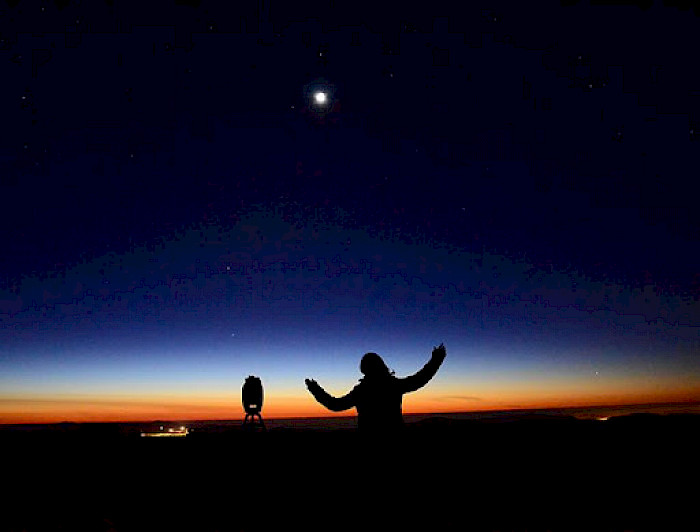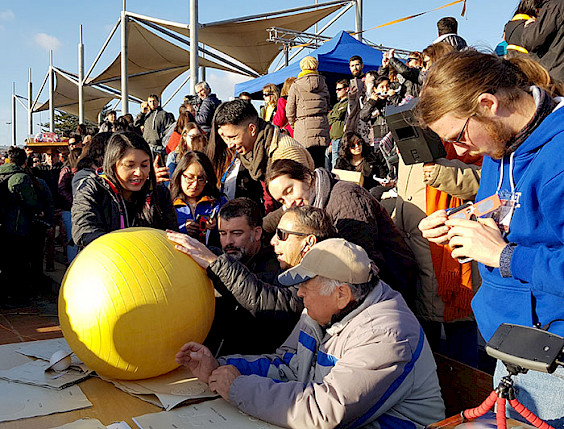Artificial Intelligence and New Technologies, the future of Astronomic Science
The main objective of the Center for Excellence in Astrophysics and Associated Technologies is to make the most of the new telescopes that have been built and will continue to be installed in Chile. UC Chile is one of the five partner universities of the Center, which is beginning its second phase.

photo_camera The second phase of the Center of Excellence in Astrophysics and Related Technologies (CATA) will emphasize technology transfer and industry links (Image: CATA)
The Center for Excellence in Astrophysics and Associated Technologies (CATA) was created in 2008 to take advantage of the unique resource of the Chilean skies.
Today, it is the largest national Center dedicated to researching and developing technologies related to astronomy in Chile.
During its first phase, the Center was led by its director -local astronomer María Teresa Ruiz-, with Universidad de Chile as the host institution, and UC Chile and Universidad de Concepción as associates.
The second phase of CATA was launched after 13 years of work and the win of the Fourth National Contest of Basal Financing for Scientific and Technological Excellence Centers, with two new partner institutions, Universidad Andrés Bello and Universidad Diego Portales.
The centre’s mission has focused on five key aspects:
- Research
- Education
- Development of high technology
- Technology transfer
- Scientific dissemination
Its new director, Guido Garay, professor of the Department of Astronomy at Universidad de Chile, and 2017 National Award of Exact Sciences winner, explained the research:
"What we have done and want to continue to do is to address fundamental problems in astrophysics, making use of the formidable telescopes that we have available, thanks to the international observatories that are in the country." By law, 10% of the astronomical observing time is reserved exclusively for Chilean researchers.
In education, the center seeks to train new generations of astrophysicists and engineers specialized in astronomical instrumentation.
To promote the development of high technology in Chile, the Center will support initiatives between astronomers and engineers.
For technology transfer, the Center will identify applications that have come out of their laboratories and that can be transferred to industry and society.
Last, but not least, is scientific dissemination. Communicating the research and its results to society, and educating society on the principles of Astronomy, is crucial for their work.
"We have been very successful in the thirteen years of our first phase. We have published close to 3,400 articles in international journals," said Guido Garay and continued:
"We have trained 380 students, both masters and doctoral. In terms of technology, we designed a radio-receiver for the ALMA observatory, which has already been commissioned, and is a really important achievement."

The Era of Artificial Intelligence
In its second phase, CATA's focus will be on technology transfer.
"We will expand what we have been already doing in instrumental development," said Patricia Tissera, professor at the UC Chile Institute of Astrophysics and senior researcher at CATA, who added:
"We will integrate artificial intelligence more explicitly. With the large databases already being generated, which will increase even more in the future, astronomy is already preparing to do science differently, using artificial intelligence techniques for data analysis and management."
CATA seeks to contribute to the training of highly qualified human resources, initially applied to astronomy, but it also aims to contribute to other sectors of society. For example, the Center has partnered with Microsoft and the University of Sussex.
There's also the CATA Liaison Program, created to combine technological development efforts with artificial intelligence, seeking to optimize the resources we have at all levels to transfer the technologies, codes, and algorithms generated more efficiently."
The idea is to work with the various partner universities that already have technology transfer centers.
As Ezequiel Treister, also a professor at the UC Institute of Astrophysics, and deputy director of CATA, explained:
"These new telescopes, these new technologies that have been installed in the country, have led us to incorporate issues of big data and artificial intelligence. We need them so that we can get the most scientific benefit from these instruments."
In addition to developing astronomical instruments, CATA seeks to promote computer system development through partnerships such as with Microsoft The partnership was born thanks to a previous collaboration program with the UC, through the Office of the Vice President for Research and the UC Chile Innovation Centre.
"We integrate cloud technologies, such as computation and storage, into our work, while Microsoft tests its software with us. At the same time, we offer our students and young researchers opportunities to learn new technologies so that they can experience the technologies used by the industry today," said Ezequiel Treister.
The agreement includes an internship program at Microsoft's locations and science outreach initiatives such as citizen science and remote observation.
"It would be interesting for the industry to recognize us as a center where problems can be raised and solutions found. We seek to have a smooth relationship between academia and stakeholders of the productive sector," added Patricia Tissera.

Renewal with a greater gender balance
During the Centre's second phase, collaboration has been extended to different universities, covering a large part of the national territory, from Arica to Concepción. "We have researchers taking part in this initiative but who do not belong to the partner universities, so we have expanded the impact of CATA to the rest of the country," said its director. They also incorporated universities that are just opening their astronomy degree programs.
Fifteen senior researchers and 42 associates from 12 different universities are currently taking part, "representing a third of Chilean astronomers with permanent positions," said Guido Garay. Also, 60% of the principal researchers were renewed, lowering the average age to 42.
Efforts have been made to improve the gender balance. Among senior researchers, the number of women has increased to 20% (from 10% in the first phase), while it increased to 25% among associate researchers.
Understanding the Secrets of the Universe
A better understanding of the "dark energy," which represents about 70% of the universe's total mass-energy, will be the main research challenge for CATA.
"With the new telescopes, we have more interesting and challenging problems, such as astrobiology, which allows us to understand how life came to exist on Earth or any other planet," explained the director.
CATA carries out research in seven areas, including cosmology, star formation, planet formation, and evolution of galaxies and solar systems.
"The aim is to make the best use of the telescopes we currently have in our country," said Professor Treister, adding that "part of the reason for this renovation is to anticipate and use these new technologies, to be prepared for what is to come, to take new challenges."
Breaking out of their comfort zone

According to Guido Garay, the greatest challenge is "to unite all of us to better understand the Universe."
"CATA brings synergies that can help generate, identify, and maximize connections. All research is connected. In this sense, a major challenge for this new phase is the link with the industry; to get out of our comfort zone and contribute to society in a concrete way beyond the research we do," said Ezequiel Treister.
Outreach goals include massifying astronomy.
"The big challenge is to approach populations that, in general, have little access. So that is where we want to be, and technology is our great ally," added Professor Treister.
The task ahead is not a small one.
What motivates these researchers?
"It's a unique opportunity to design something more comprehensive, challenging. In addition, I am very motivated by technology transfer, as astronomy is also a powerful engine of technological progress that we should be developing," said Professor Patricia Tissera.
"Contributing to national astronomy, being at the frontier of knowledge, and training young people who will be the future champions of world astronomy is what motivates me," added Guido Garay.
Ezequiel Treister concluded:
"We know we have a lot to contribute. But, hopefully, in ten years, we will say that we have contributed a grain of sand. I believe astronomy has the potential to help build a better Chile. We are lucky enough to live in the country with the best skies globally, and we have to take advantage of it!"


